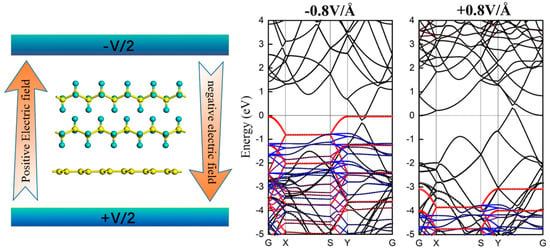Electronic Structure and External Electric Field Modulation of Polyethylene/Graphene Interface
Abstract
:1. Introduction
2. Materials and Methods
3. Results and Discussion
3.1. Structural Features of the PE/G Interfaces
3.2. Electronic Structures of the PE/G Interfaces
3.3. Electric Field Effects on the PE/G Interfaces
4. Conclusions
Author Contributions
Funding
Conflicts of Interest
References
- Yan, J.; Huang, Y.; Liu, X.D.; Zhao, X.X.; Li, T.H.; Zhao, Y.; Liu, P.B. Polypyrrole-based composite materials for electromagnetic wave absorption. Polym. Rev. 2021, 61, 646–687. [Google Scholar] [CrossRef]
- Wu, Z.C.; Cheng, H.W.; Jin, C.; Yang, B.T.; Xu, C.Y.; Pei, K.; Zhang, H.B.; Yang, Z.Q.; Che, R.C. Dimensional design and core-shell engineering of nanomaterials for electromagnetic wave absorption. Adv. Mater. 2022, 34, 2107538. [Google Scholar] [CrossRef] [PubMed]
- Liang, L.L.; Gu, W.H.; Wu, Y.; Zhang, B.S.; Wang, G.H.; Yang, Y.; Ji, G.B. Heterointerface engineering in electromagnetic absorbers: New insights and opportunities. Adv. Mater. 2022, 34, 2106195. [Google Scholar] [CrossRef]
- Gupta, T.K.; Singh, B.P.; Dhakate, S.R.; Singh, V.N.; Mathur, R.B. Improved nanoindentation and microwave shielding properties of modified MWCNT reinforced polyurethane composites. J. Mater. Chem. A 2013, 1, 9138–9149. [Google Scholar] [CrossRef]
- Mohammed, H.; Saleh, A.; Saadeha, W.H.; Sundararaj, U. EMI shielding effectiveness of carbon based nanostructured polymeric materials: A comparative study. Carbon 2013, 60, 146–156. [Google Scholar] [CrossRef]
- Yuan, Y.; Qu, Z.M.; Wang, Q.G.; Sun, X.N.; Cheng, E.W. Reversible nonlinear I-V behavior of ZnO-decorated graphene nanoplatelets/epoxy resin composites. Polymers 2020, 12, 951. [Google Scholar] [CrossRef] [Green Version]
- Yuan, Y.; Qu, Z.M.; Wang, Q.G.; Sun, X.N. Nonlinear conductive characteristics of ZnO-coated graphene nanoplatelets-carbon nanotubes/epoxy resin composites. Polymers 2020, 12, 1634. [Google Scholar] [CrossRef]
- Wang, H.; Zheng, K.; Zhang, X.; Du, T.X.; Xiao, C.; Ding, X.; Bao, C.; Chen, L.; Tian, X.Y. Segregated poly(vinylidene fluoride)/MWCNTs composites for high-performance electromagnetic interference shielding. Compos. Part A Appl. Sci. Manuf. 2016, 90, 606–613. [Google Scholar] [CrossRef]
- Ling, J.; Zhai, W.; Feng, W.; Shen, B.; Zhang, J.; Zheng, W.G. Facile preparation of lightweight microcellular polyetherimide/graphene composite foams for electromagnetic interference shielding. ACS Appl. Mater. Interfaces 2013, 5, 2677–2684. [Google Scholar] [CrossRef]
- Yang, Y.L.; Gupta, M.C.; Dudley, K.L.; Lawrence, R.W. A comparative study of EMI shielding properties of carbon nanofiber and multi-walled carbon nanotube filled polymer composites. J. Nanosci. Nanotechnol. 2005, 5, 927–931. [Google Scholar] [CrossRef]
- Kausar, A. Shape memory polymer/graphene nanocomposites: State-of-the-art. e-Polymers 2022, 22, 165–181. [Google Scholar] [CrossRef]
- Li, H.; Yuan, D.; Li, P.C.; He, C.B. High conductive and mechanical robust carbon nanotubes/waterborne polyurethane composite films for efficient electromagnetic interference shielding. Compos. Part A Appl. Sci. Manuf. 2019, 121, 411–417. [Google Scholar] [CrossRef]
- Yu, W.C.; Xu, J.Z.; Wang, Z.G.; Huang, Y.F.; Yin, H.M.; Xu, L.; Chen, Y.W.; Yan, D.X.; Li, Z.M. Constructing highly oriented segregated structure towards high-strength carbon nanotube/ultrahigh-molecular-weight polyethylene composites for electromagnetic interference shielding. Compos. Part A Appl. Sci. Manuf. 2018, 110, 237–245. [Google Scholar] [CrossRef]
- Ren, F.; Li, Z.; Xu, L.; Sun, Z.F.; Ren, P.G.; Yan, D.X.; Li, Z.M. Large-scale preparation of segregated PLA/carbon nanotube composite with high efficient electromagnetic interference shielding and favourable mechanical properties. Compos. B Eng. 2018, 155, 405–413. [Google Scholar] [CrossRef]
- Bouriche, S.; Makhlouf, M.; Kadari, M.; Bakli, H.; Hamoumi, Y.; Benaicha, B.; Taibi, A.; Benmaamar, Z. Smart membrane absorbing electromagnetic waves based on polyvinyl chloride/graphene composites. Mater. Res. Express 2022, 9, 45703. [Google Scholar] [CrossRef]
- Verma, M.; Chauhan, S.S.; Dhawan, S.K.; Choudhary, V. Graphene nanoplatelets/carbon nanotubes/polyurethane composites as efficient shield against electromagnetic polluting radiations. Compos. B. Eng. 2017, 120, 118–127. [Google Scholar] [CrossRef]
- Milani, A. A revisitation of the polymorphism of poly(butylene-2,6-naphthalate) from periodic first-principles calculations. Polymer 2014, 55, 3729–3735. [Google Scholar] [CrossRef]
- Milani, A.; Galimberti, D.R. Polymorphism of poly(butylene terephthalate) investigated by means of periodic density functional theory calculations. Macromolecules 2014, 47, 1046–1052. [Google Scholar] [CrossRef]
- Sato, M. Charge conduction in polymer dielectrics: Theoretical perspectives and first-principle approaches. IEEE Trans. Dielectr. Electr. Insul. 2021, 28, 520–540. [Google Scholar] [CrossRef]
- Avanzini, L.; Brambilla, L.; Marano, C.; Milani, A. Strain-dependent vibrational spectra and elastic modulus of poly(p-phenylene terephtalamide) from first-principles calculations. Polymer 2017, 116, 133–142. [Google Scholar] [CrossRef]
- Orasugh, J.T.; Ray, S.S. Prospect of DFT utilization in polymer-graphene composites for electromagnetic interference shielding application: A review. Polymers 2022, 14, 704. [Google Scholar] [CrossRef] [PubMed]
- Sun, Y.; Boggs, S.A.; Ramprasad, R. The intrinsic electrical breakdown strength of insulators from first principles. Appl. Phys. Lett. 2012, 101, 132906. [Google Scholar] [CrossRef] [Green Version]
- Sun, Y.; Bealing, C.; Boggs, S.; Ramprasad, R. 50+ years of intrinsic breakdown. IEEE Electr. Insul. Mag. 2013, 29, 8–15. [Google Scholar] [CrossRef]
- Saiz, F.; Quirke, N. The excess electron in polymer nanocomposites. Phys. Chem. Chem. Phys. 2018, 20, 27528–27538. [Google Scholar] [CrossRef] [PubMed] [Green Version]
- Yu, L.; Ranjan, V.; Nardelli, M.B.; Bernholc, J. First-principles investigations of the dielectric properties of polypropylene/metal-oxide interfaces. Phys. Rev. B 2009, 80, 165432. [Google Scholar] [CrossRef] [Green Version]
- Saiz, F.; Cubero, D.; Quirke, N. The excess electron at polyethylene interfaces. Phys. Chem. Chem. Phys. 2018, 20, 25186–25194. [Google Scholar] [CrossRef] [Green Version]
- Kubyshkina, E.; Unge, M.; Jonsson, B.L.G. Communication: Band bending at the interface in polyethylene-MgO nanocomposite dielectric. J. Chem. Phys. 2017, 146, 51101. [Google Scholar] [CrossRef] [Green Version]
- Sato, M.; Kumada, A.; Hidaka, K.; Sekiguchi, Y. Probing the effect of surface modification of MgO filler on charge transport in polyethylene/MgO composites: From an electronic structure viewpoint. IEEE Trans. Dielectr. Electr. Insul. 2021, 28, 815–821. [Google Scholar] [CrossRef]
- Gaska, K.; Xu, X.; Gubanski, S.; Kádár, R. Electrical, mechanical, and thermal properties of LDPE graphene nanoplatelets composites produced by means of melt extrusion process. Polymers 2017, 9, 11. [Google Scholar] [CrossRef] [Green Version]
- Apátiga, J.L.; Del Castillo, R.M.; Del Castillo, L.F.; Calles, A.G.; Espejel-Morales, R.; Favela, J.F.; Compañ, V. Non-covalent interactions on polymer-graphene nanocomposites and their effects on the electrical conductivity. Polymers 2021, 13, 1714. [Google Scholar] [CrossRef]
- Güryel, S.; Alonso, M.; Hajgató, B.; Dauphin, Y.; van Lier, G.; Geerlings, P.; de Proft, F. A computational study on the role of noncovalent interactions in the stability of polymer/graphene nanocomposites. J. Mol. Model. 2017, 23, 43. [Google Scholar] [CrossRef] [PubMed]
- Kresse, G.; Furthmüller, J. Efficient iterative schemes for ab initio total-energy calculations using a plane-wave basis set. Phys. Rev. B 1996, 54, 11169–11186. [Google Scholar] [CrossRef]
- Kresse, G.; Furthmüller, J. Efficiency of ab-initio total energy calculations for metals and semiconductors using a plane-wave basis set. Comput. Mater. Sci. 1996, 6, 15–50. [Google Scholar] [CrossRef]
- Perdew, J.P.; Burke, K.; Ernzerhof, M. Generalized gradient approximation made simple. Phys. Rev. Lett. 1996, 77, 3865–3868. [Google Scholar] [CrossRef] [PubMed] [Green Version]
- Román-Pérez, G.; Soler, J.M. Efficient implementation of a van der Waals density functional: Application to double-wall carbon nanotubes. Phys. Rev. Lett. 2009, 103, 96102. [Google Scholar] [CrossRef] [Green Version]
- Grimme, S.; Ehrlich, S.; Goerigk, L. Effect of the damping function in dispersion corrected density functional theory. J. Comput. Chem. 2011, 32, 1456. [Google Scholar] [CrossRef]
- Petersen, R.; Pedersen, T.G.; Jauho, A.P. Clar sextet analysis of triangular, rectangular, and honeycomb graphene antidot lattices. ACS Nano 2011, 81, 109–162. [Google Scholar] [CrossRef] [Green Version]
- Kleis, J.; Lundqvist, B.I.; Langreth, D.C.; Schröder, E. Towards a working density-functional theory for polymers: First-principles determination of the polyethylene crystal structure. Phys. Rev. B 2007, 76, 100201. [Google Scholar] [CrossRef] [Green Version]
- Serra, S.; Tosatti, E.; Iarlori, S.; Scandolo, S.; Santoro, G. Interchain electron states in polyethylene. Phys. Rev. B 2000, 62, 4389. [Google Scholar] [CrossRef]
- Jia, T.T.; Zheng, M.M.; Fan, X.Y.; Su, Y.; Li, S.J.; Liu, H.Y.; Chen, G.; Kawazoe, Y. Dirac cone move and bandgap on/off switching of graphene superlattice. Sci. Rep. 2016, 6, 18869. [Google Scholar] [CrossRef] [Green Version]
- Varykhalov, A.; Sánchez-Barriga, J.; Marchenko, D.; Hlawenka, P.; Mandal, P.S.; Rader, O. Tunable Fermi level and hedgehog spin texture in gapped graphene. Nat. Commun. 2015, 6, 7610. [Google Scholar] [CrossRef] [PubMed]
- Burke, K. Perspective on density functional theory. J. Chem. Phys. 2012, 136, 150901. [Google Scholar] [CrossRef]
- Park, C.H.; Louie, S.G. Energy gaps and stark effect in boron nitride nanoribbons. Nano Lett. 2008, 8, 2200–2203. [Google Scholar] [CrossRef] [PubMed] [Green Version]
- Yue, Q.; Chang, S.L.; Kang, J.; Zhang, X.A.; Shao, Z.Z.; Qin, S.Q.; Li, J.B. Bandgap tuning in armchair MoS2 nanoribbon. J. Phys. Condens. Matter 2012, 24, 335501. [Google Scholar] [CrossRef] [PubMed] [Green Version]





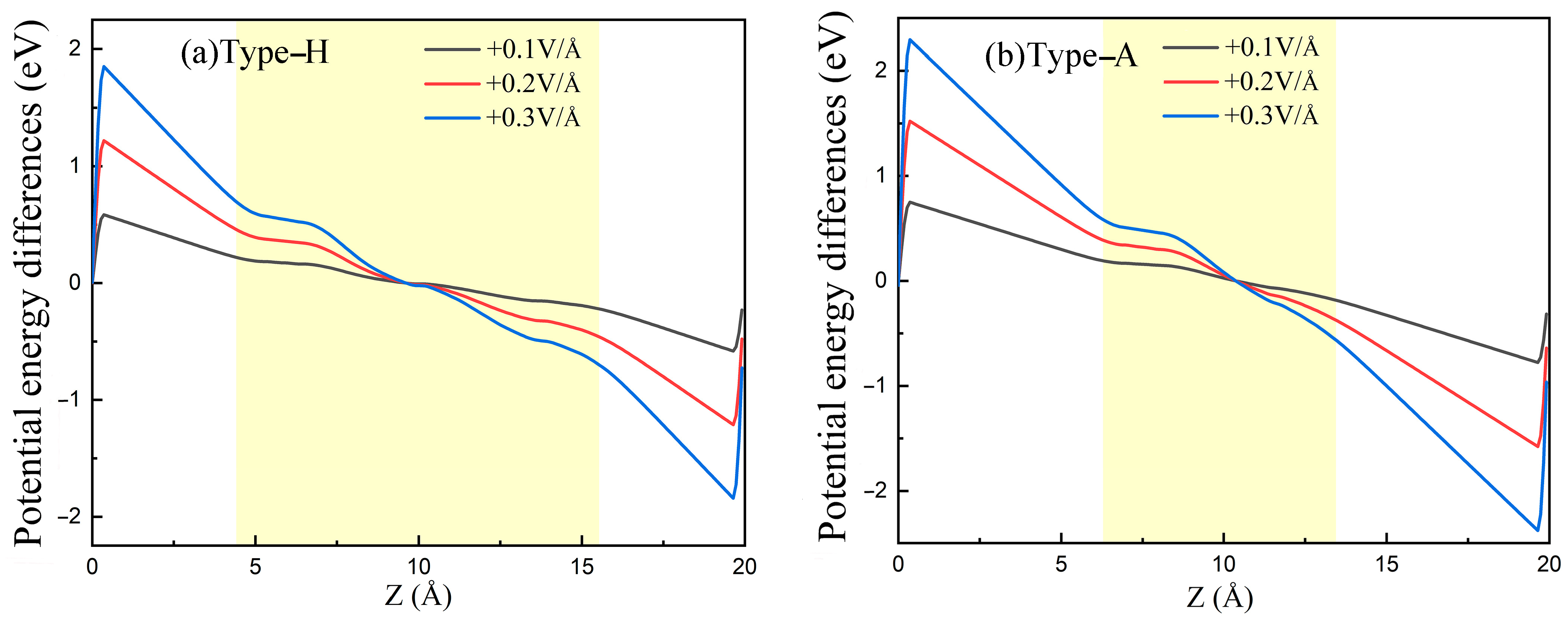
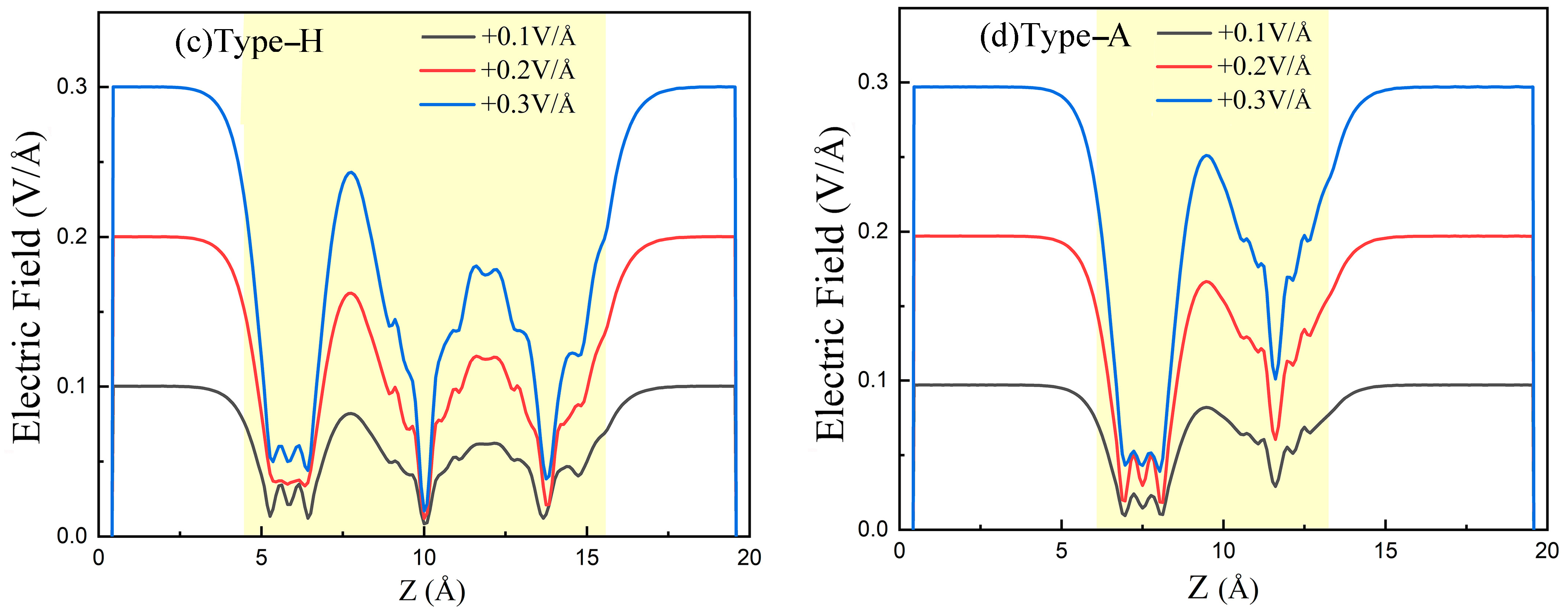
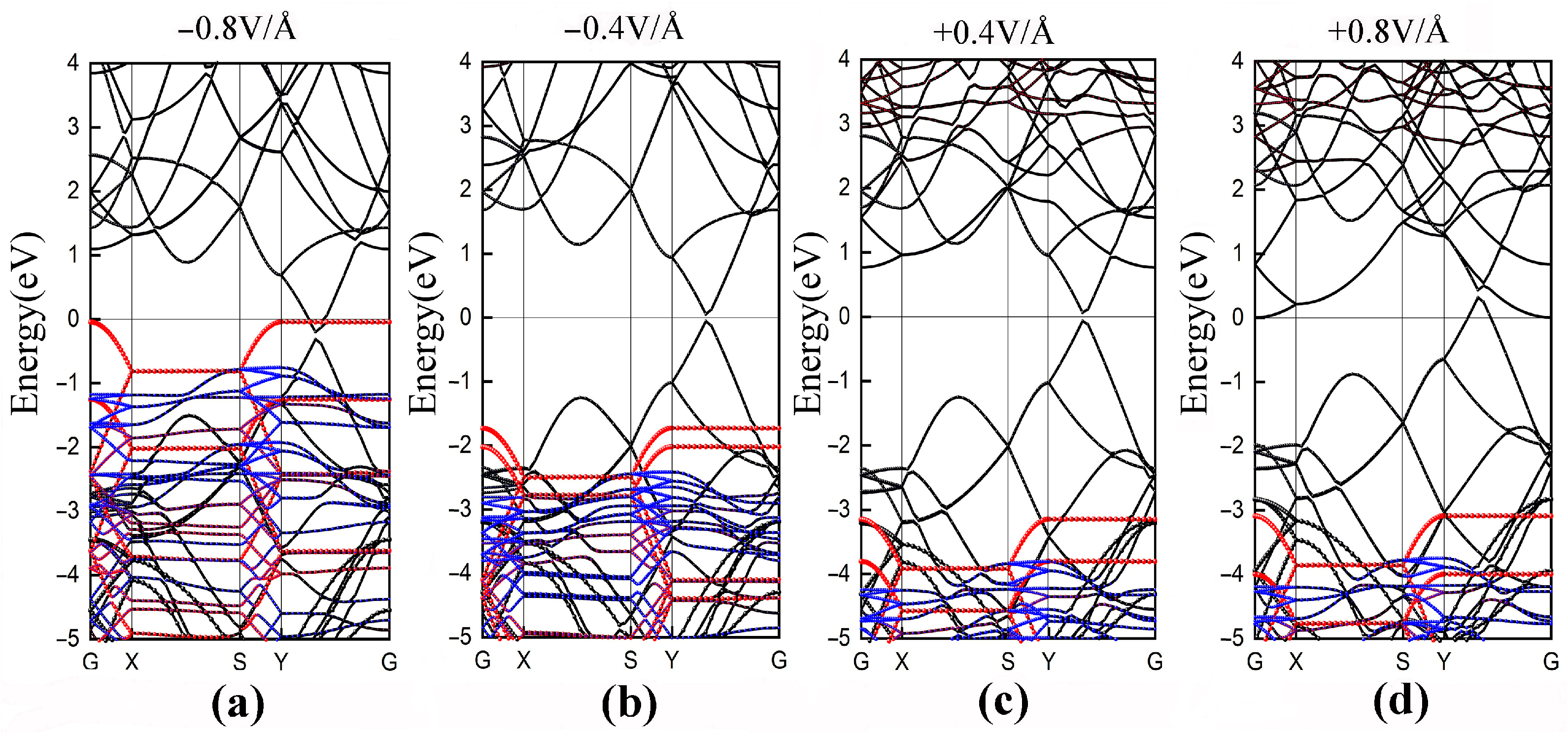
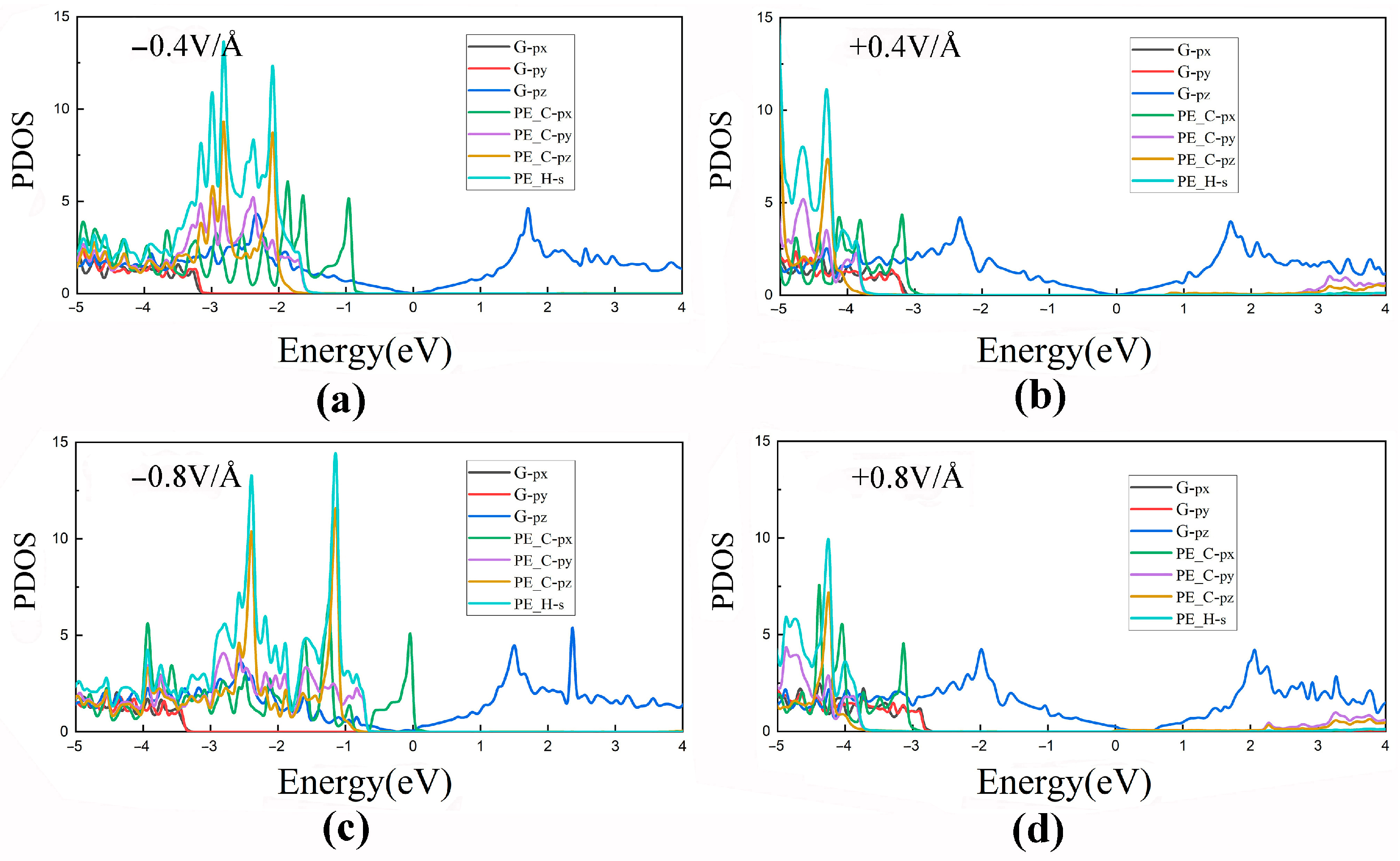

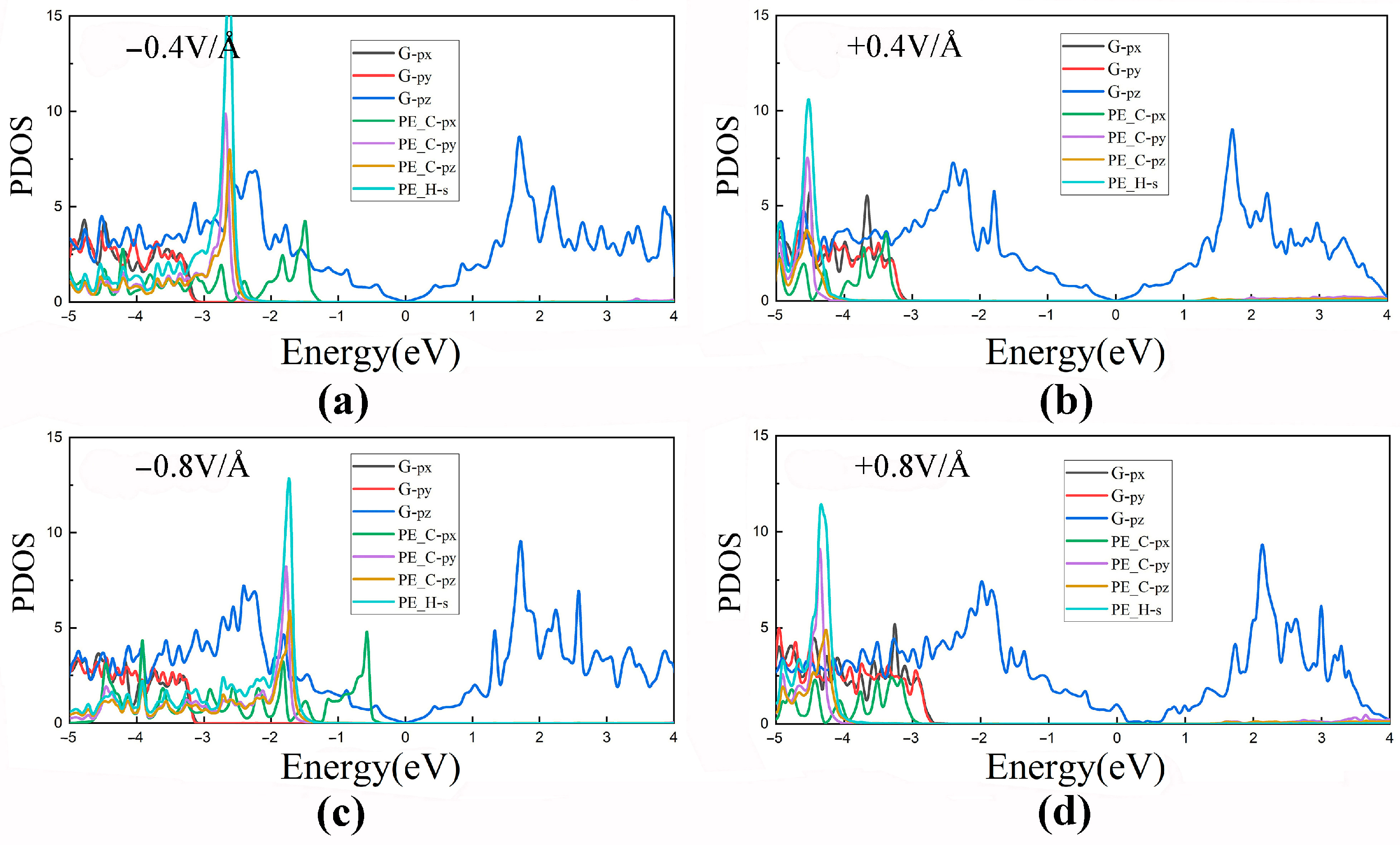
| Graphene | Polyethylene | ||||
|---|---|---|---|---|---|
| a0 /Å | 4.26 1 | 4.26 | 7.12 2 | 7.40 3 | 7.18 |
| b0/Å | 2.46 1 | 2.46 | 4.85 2 | 4.93 3 | 4.94 |
| c0/Å | - | - | 2.57 2 | 2.53 3 | 2.56 |
| Type-H | Type-A | |
|---|---|---|
| a/Å | 12.8 | 12.8 |
| b/Å | 4.93 | 9.86 |
| dC-C/Å | 1.536 | 1.536 |
| dC-H/Å | 1.103 | 1.102 |
| d/Å | 2.76 | 2.67 |
| Eb/eV | −0.76 | −0.72 |
Publisher’s Note: MDPI stays neutral with regard to jurisdictional claims in published maps and institutional affiliations. |
© 2022 by the authors. Licensee MDPI, Basel, Switzerland. This article is an open access article distributed under the terms and conditions of the Creative Commons Attribution (CC BY) license (https://creativecommons.org/licenses/by/4.0/).
Share and Cite
Li, H.; Qu, Z.; Chen, Y.; Zhou, L.; Wang, Y. Electronic Structure and External Electric Field Modulation of Polyethylene/Graphene Interface. Polymers 2022, 14, 2949. https://doi.org/10.3390/polym14142949
Li H, Qu Z, Chen Y, Zhou L, Wang Y. Electronic Structure and External Electric Field Modulation of Polyethylene/Graphene Interface. Polymers. 2022; 14(14):2949. https://doi.org/10.3390/polym14142949
Chicago/Turabian StyleLi, Hongfei, Zhaoming Qu, Yazhou Chen, Linsen Zhou, and Yan Wang. 2022. "Electronic Structure and External Electric Field Modulation of Polyethylene/Graphene Interface" Polymers 14, no. 14: 2949. https://doi.org/10.3390/polym14142949





